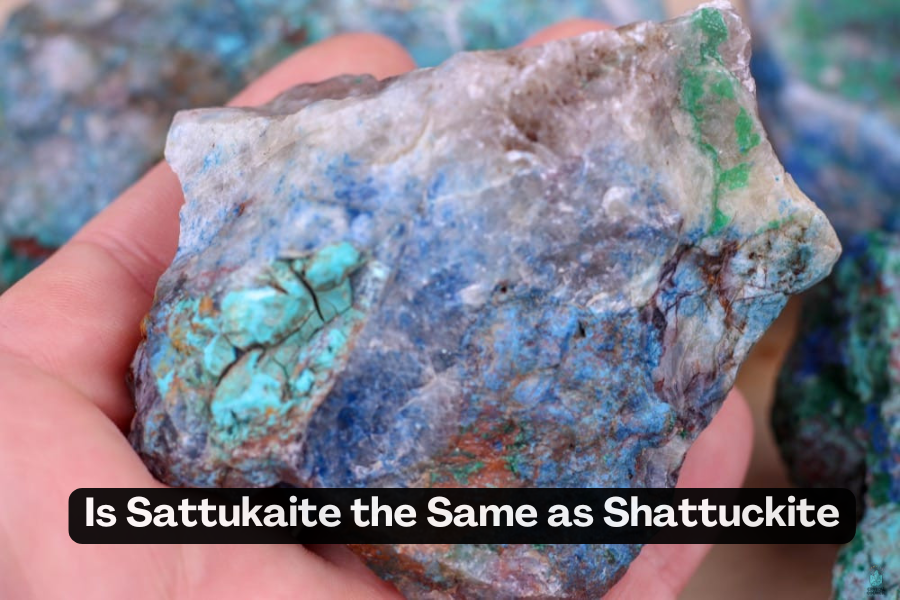The Mystery of Sattukaite
The term “Sattukaite” has gained attention in various discussions and gemstone listings. However, Sattukaite is not officially recognized as a distinct mineral by the scientific community. Instead, it appears to be a misspelling or misinterpretation of Shattuckite. Despite the confusion, the two names likely refer to the same mineral, with Sattukaite emerging as a typographical error or misunderstanding.
Why People Frequently Ask: “Is Sattukaite the Same as Shattuckite?”
The question “Is Sattukaite the Same as Shattuckite?” often comes up due to the close resemblance between the two names and the visual similarity between the minerals. The term “Sattukaite” appears occasionally in online sales listings and discussions, leading many collectors and enthusiasts to wonder if it is another name for Shattuckite or if it represents a completely separate mineral. This confusion is further compounded by the fact that both minerals share the same blue or green hues, which are common in copper-based stones.
Shattuckite: A Fascinating Copper Mineral
Shattuckite is a distinctive copper silicate mineral, with the chemical composition Cu₅(SiO₃)₄(OH)₂. Composed mainly of copper, silicon, and oxygen, it forms in copper-rich deposits, where its vibrant blue to green color is directly tied to the copper content. Named after the Shattuck Mine in Bisbee, Arizona, where it was first discovered, Shattuckite is closely related to other copper silicates like Chrysocolla and Azurite, sharing many similar chemical traits.
Shattuckite’s Key Features: Color, Hardness, and Structure
The most eye-catching feature of Shattuckite is its striking color, which can range from a rich blue to turquoise or green. The exact shade can differ based on its mineral composition, but it’s always vibrant and noticeable. On the Mohs hardness scale, Shattuckite falls between 3.5 and 4, making it a relatively soft stone. This means it is more vulnerable to scratching when compared to harder gemstones such as diamonds or sapphires.
The Origin of Shattuckite
Shattuckite was initially discovered at the Shattuck Mine in Bisbee, Arizona, a site with a long history of copper mining. Alongside Shattuckite, the mine has also yielded other well-known copper-based minerals such as Chrysocolla and Malachite, contributing to the region’s reputation for diverse and fascinating mineral deposits. Other notable sources of Shattuckite include areas in Namibia and the Democratic Republic of Congo (DRC), both of which have produced exceptional specimens.
Is Sattukaite a Real Mineral?
To answer simply: No, Sattukaite is not a genuine mineral. Unlike Shattuckite, which is well-documented and scientifically recognized, Sattukaite appears to be a mistake or confusion. There is no formal acknowledgment of “Sattukaite” in the world of gemology or mineralogy, and it is often used incorrectly by less experienced sellers or collectors who mistakenly label Shattuckite under this name.
How the Term “Sattukaite” Likely Came About
The emergence of the term “Sattukaite” is likely the result of a typographical mistake or misunderstanding. Given Shattuckite’s rarity and its striking blue-green color, it’s easy to see how someone might misspell its name or mislabel similar-looking minerals as “Sattukaite.” Such errors are common, especially in online mineral listings where inaccuracies can easily spread.
Why the Confusion About Sattukaite and Shattuckite Exists
The question “Is Sattukaite the Same as Shattuckite?” arises due to the overlapping features of both terms. Both refer to minerals associated with copper and share similar visual traits, particularly their blue and green colors. However, as previously mentioned, Sattukaite is not a recognized mineral, and this confusion mostly stems from the similarity in their names and the shared copper-based nature of both.
Key Differences Between Shattuckite and Sattukaite
The most significant difference between Shattuckite and Sattukaite is that Sattukaite is not a legitimate mineral. Shattuckite, on the other hand, is scientifically recognized and documented. While they may appear similar in color, Shattuckite is a rare mineral with a unique chemical structure that sets it apart from other copper-based stones.
Chemical Structure and Composition
Shattuckite has a specific chemical formula: Cu₅(SiO₃)₄(OH)₂, which is integral to its identity as a copper silicate mineral. This defined structure gives Shattuckite its characteristic properties. There is no established chemical composition for Sattukaite, which further reinforces that it is not a distinct mineral.
Visual Similarities and Differences
Both Shattuckite and the term “Sattukaite” are often linked to beautiful blue and turquoise-green colors that are typical of copper silicate minerals. However, Shattuckite tends to have a more consistent color and a clearly identifiable crystalline structure, making it easier to recognize. In contrast, “Sattukaite” lacks the consistency and official recognition of Shattuckite, adding to the confusion about its true identity.
Shattuckite’s Locations: Where Can It Be Found?
Shattuckite is typically found in copper-rich areas, with the Shattuck Mine in Bisbee, Arizona, being the most famous location for this mineral. This mine has produced some of the finest examples of Shattuckite, alongside other copper minerals. Additionally, high-quality Shattuckite specimens have been discovered in Namibia and the Democratic Republic of Congo (DRC).
Prominent Sources of Shattuckite
- Arizona: The Shattuck Mine in Bisbee, Arizona, is the most well-known source of Shattuckite, renowned for producing some of the best specimens of this mineral.
- Namibia: Namibia, with its abundant copper deposits, is another notable source of stunning Shattuckite crystals.
- Democratic Republic of Congo: The DRC has also contributed significantly to the availability of Shattuckite, offering high-quality specimens prized by collectors.
The Metaphysical and Healing Qualities of Shattuckite
Shattuckite holds significance in metaphysical circles, particularly for its connection to the throat and third-eye chakras, which govern communication and intuition. It is believed that using Shattuckite can help open and balance these chakras, improving one’s ability to express themselves and heighten intuitive abilities.
Shattuckite in Healing Practices
In the world of crystal healing, Shattuckite is valued for its ability to promote clarity, mental focus, and emotional healing. It is thought to support self-expression and remove blockages in communication, making it a popular choice for those seeking to enhance their personal expression and emotional balance.
Identifying Shattuckite
Shattuckite is fairly easy to identify due to its vivid blue-green color and unique crystal formation. It often forms in botryoidal (grape-like) clusters with a smooth texture. To distinguish it from other similar minerals, focus on its bright color and relative softness, as it falls lower on the Mohs scale compared to harder minerals.
Shattuckite vs Other Similar Copper-Based Minerals (Chrysocolla, Azurite)
While Shattuckite may resemble other copper silicate minerals, such as Chrysocolla or Azurite, it can typically be distinguished by its brighter colors and distinct chemical composition. Gemologists can perform various tests, such as hardness tests and chemical analysis, to confirm the mineral’s true identity.
Shattuckite in Jewelry and Its Practical Uses
Shattuckite’s vibrant hues make it a favored gemstone for crafting jewelry, particularly for pieces like pendants and earrings, where minimal physical contact reduces the risk of damage. Given its softer texture, it’s not ideal for rings or bracelets that endure regular wear and tear. Despite this, Shattuckite is still highly valued for its aesthetic beauty and metaphysical significance in jewelry design.
Healing, Meditation, and Other Practical Applications
In addition to its use in jewelry, Shattuckite plays a significant role in metaphysical practices. It is commonly utilized in meditation, where it aids in clearing mental blocks and improving communication. Spiritual healers often work with Shattuckite to balance the throat and third-eye chakras, fostering self-expression and enhancing intuition. Whether used alone or in combination with other crystals, Shattuckite is believed to promote emotional healing and support personal growth.
Caring for Shattuckite
Due to its relatively low hardness, rated between 3.5 and 4 on the Mohs scale, Shattuckite requires careful attention. To preserve its appearance and prevent wear, it’s essential to avoid exposing it to harsh chemicals or physical impact. Cleaning it with a soft cloth and warm water, and storing it away from harder stones, ensures its longevity.
Clarifying the Confusion Between Sattukaite and Shattuckite
As previously discussed, the term “Sattukaite” is not a valid mineral. It’s likely a result of misspelling or miscommunication, often used by sellers or collectors unfamiliar with Shattuckite. While Shattuckite is a scientifically recognized copper silicate mineral, Sattukaite doesn’t exist in the mineralogical field. When you encounter the term “Sattukaite,” it’s generally referring to Shattuckite.
Is Shattuckite Suitable for Jewelry?
Yes, Shattuckite can be incorporated into jewelry. However, due to its relatively soft nature, it’s best suited for pieces like earrings or pendants, which are less prone to damage. It’s especially appreciated by collectors for its striking color and metaphysical properties, making it an excellent choice for decorative pieces.
Healing Benefits Associated with Shattuckite
Shattuckite is renowned for its metaphysical qualities, particularly its effects on the throat and third-eye chakras. It’s believed to enhance communication, mental clarity, and intuition. Many use Shattuckite for emotional healing, self-expression, and meditation, as it’s thought to help maintain calm and focus. Those looking to improve their communication skills or strengthen their intuitive connections often turn to Shattuckite for assistance.
The Importance of Accurate Mineral Identification
Correctly identifying minerals is crucial, especially when distinguishing between similar-looking stones. Misidentification, especially between minerals like Shattuckite and Sattukaite, can lead to confusion and misrepresentation. Gemologists and mineral experts are vital in providing accurate identification and ensuring that collectors and enthusiasts have reliable information about the stones they acquire.
Why Proper Identification of Minerals Matters
When identifying Shattuckite, it’s essential to differentiate it from other copper-based minerals such as Chrysocolla, Azurite, or Malachite. Shattuckite typically exhibits a deeper blue color and forms in botryoidal clusters, which make it distinguishable from these other minerals. A gemologist can further verify its identity through tests on its chemical composition and hardness.
The Role of Gemologists in Identifying Shattuckite
Trained gemologists are experts in the identification of minerals. If you’re uncertain whether your specimen is genuine Shattuckite or if you’ve encountered a term like “Sattukaite,” consulting a professional gemologist is the best course of action. They can provide expert advice on the mineral’s authenticity, value, and origin.
Key Facts
Sattukaite Does Not Exist: The term “Sattukaite” is not a recognized mineral. It’s likely a typographical error or misnomer used by sellers or collectors. The correct term is Shattuckite.
Shattuckite Is a Real Mineral: Shattuckite is a rare copper silicate mineral known for its striking blue color and metaphysical properties. It is scientifically documented and highly valued by gemologists and collectors.
Sattukaite Likely Refers to Shattuckite: When people mention “Sattukaite,” they are most likely referring to Shattuckite. The confusion arises due to the similarity in the names, but there is no mineral called Sattukaite in scientific literature.
Shattuckite’s Properties: Shattuckite is prized not only for its visual beauty but also for its metaphysical properties. It is believed to enhance communication, intuition, and clarity, especially when used in spiritual practices such as meditation.
Shattuckite in Jewelry: Due to its soft nature (3.5–4 on the Mohs scale), Shattuckite is typically used in jewelry items like pendants and earrings rather than rings or bracelets that experience frequent wear.
Misidentification Risks: Misidentifying Shattuckite as “Sattukaite” can lead to confusion and incorrect purchases, especially for collectors or those seeking the mineral for metaphysical purposes.
No Scientific Recognition of “Sattukaite”: There are no mineralogical records or references to a mineral called “Sattukaite.” The correct term to use when referring to the blue, copper-based mineral is Shattuckite.
Gemological Expertise: If you come across “Sattukaite” in a mineral or gemstone context, consulting a gemologist can help clarify the identity of the mineral and confirm whether it’s Shattuckite.
Geographical Occurrence: Shattuckite is mainly found in places like Bisbee, Arizona, and Namibia, and it is known for forming in botryoidal clusters, which further distinguishes it from other copper-based minerals.
Healing and Metaphysical Uses: Beyond jewelry, Shattuckite is used in metaphysical healing, particularly to aid in clearing mental blocks and enhancing verbal communication, making it a popular choice among healers and spiritual practitioners.
In Summary
The confusion between Sattukaite and Shattuckite stems from the improper use of the name “Sattukaite,” which refers to Shattuckite, a legitimate and rare copper silicate mineral. Shattuckite is highly valued for its distinctive blue color, its metaphysical properties, and its application in jewelry. Although “Sattukaite” is not scientifically recognized, it is commonly used incorrectly in the mineral community, leading to questions like, “Is Sattukaite the Same as Shattuckite?” The answer is clear: Sattukaite is not a real mineral, and it’s simply an erroneous term for Shattuckite.
Though confusion around Shattuckite and Sattukaite might persist due to their similar names, understanding the origins and characteristics of Shattuckite will help you navigate the world of gemstones with confidence. Whether you’re a gemstone collector, a metaphysical practitioner, or simply interested in the healing properties of crystals, Shattuckite remains a fascinating and valuable mineral. Just be cautious when encountering “Sattukaite,” as it’s nothing more than an incorrect reference to Shattuckite—the stunning copper silicate stone.
With this article, we hope the question “Is Sattukaite the Same as Shattuckite?” is now clear. Whether you’re collecting, studying, or using Shattuckite for its metaphysical benefits, knowing its true identity is crucial. If you come across “Sattukaite” in your gemstone research, remember that it’s likely just a mistake for Shattuckite, a mineral known for its mesmerizing appearance and powerful energy.
This guide has provided an in-depth look at both Shattuckite and the confusion surrounding the term “Sattukaite,” clarifying the mineral’s properties, its significance in gemology and metaphysical practices, and how to identify it accurately.
Frequently Asked Questions
Is Sattukaite the Same as Shattuckite?
No, Sattukaite is not an official mineral. It’s likely a typo or an incorrect term for Shattuckite, a rare copper silicate mineral.
What Are the Uses of Shattuckite?
Shattuckite is used in jewelry and is also appreciated for its metaphysical qualities, particularly in enhancing communication and intuition.
Where Can Shattuckite Be Found?
Shattuckite is primarily found in regions like Bisbee, Arizona, Namibia, and the Democratic Republic of Congo.
What Are the Healing Properties of Shattuckite?
Shattuckite is believed to assist with communication, emotional healing, and boosting psychic abilities, particularly through the throat and third-eye chakras.
How Can I Recognize Shattuckite?
Shattuckite is typically blue or blue-green in color, soft to the touch (with a hardness of 3.5–4 on the Mohs scale), and often forms in botryoidal clusters. A gemologist can confirm its identity using chemical testing.
Stay in touch to get more news & updates on World Trend!





